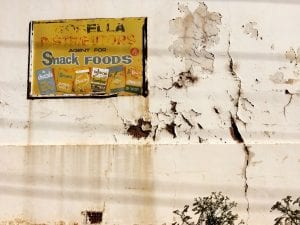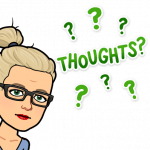
(Reflection on ETL503 Resourcing the Curriculum Module 2)
When ‘resourcing the curriculum,’ as a teacher librarian I will need to remember lots of information as mentioned in the module. I will also need to remember two things:
- Beautiful doesn’t always mean new, (see image) and
- Sometimes patron/student needs outweigh their wants. (*See below)
1. New things aren’t always the best things. My grandmother’s recipe for chicken and dumplings far outweighs any new dishes that my mother or my aunts dreamt up for our yearly Thanksgiving or Christmas feasts. Old buildings using engineers, fine brickwork, stone masonry or intricate carpentry far outweigh cardboard or plastic construction-particularly in times of natural disasters like earthquakes.
Should digital resources replace physical resources? If new is perceived as better, then will Artificial Intelligence replace teachers? Guilherme (2019) goes into this with a powerful depth. We are facilitators, but we are also teachers. We are providers of information but we also teach the skills to interpret the information and utilise it in life.
2. A key factor in ‘resourcing the curriculum’ is that it reinforces the concept of ‘information as a commodity.’ As much as we’d like libraries and information to be free, the fact is that neither are without cost. (Whether that cost is paid by taxes or individuals is a political debate for another day.)
In terms of ‘information as a commodity,’ this has some powerful landmines. The idea that information can have ownership has led to a strong community of hackers whose primary function is to provide information that someone or a corporation has deemed ‘a commodity’ and opportunity for profit.
For librarians, ‘information as a commodity’ is also full of landmines. We are adults, we are educated, we have a job to facilitate the education of students. We are also, gendered, cultural, geographical, and loaded with our own personal string of internal bias.
*Does the student voice of their needs or wants, outweigh what society (and the teacher librarian) view as student needs or wants or vice versa?
 I would like to review my personal bias and society’s bias towards the voices and contexts of students as discussed in Shirley Steinberg’s most recently edited book: Kinderculture (2018)
I would like to review my personal bias and society’s bias towards the voices and contexts of students as discussed in Shirley Steinberg’s most recently edited book: Kinderculture (2018)
I am having a lot of colliding thoughts about ‘engaging learners’ and fulfilling ‘needs’ of the learners &/or the school community and ‘who has the final say’ in resourcing the curriculum.
I say colliding because I have taught at so many different schools (South West Sydney, Far West, casually and through temporary engagement, RFF, classroom teaching, job share, etc) and can see a common lack of consideration for sociocultural context of students for programming and planning. If programming and planning were a building, the foundation is the sociocultural context. Without a sound knowledge of the school’s foundation, the building / educational program will crumble and resourcing the curriculum becomes moot. The library starts to fail or becomes irrelevant. The funding decreases. The principal sees no point in allocating a qualified TL. People start throwing around the idea of getting rid of a library altogether. In the distance: sirens.
Yesterday I worked at a geographically isolated and drought affected primary school with a large number of students from very low SES, high evidence of trauma (large ATSI population, witnesses of or suffers of domestic violence, neglect, alcohol / drug / physical / mental / emotional abuse / deaths in the family), higher than state average numbers of students with diagnosed and undiagnosed disabilities (including lead affected disabilities due to historical mining practises) and the students in this area are, overall, not meeting state expectations based on NAPLAN results. In my area, there are a statistically higher numbers of these things in all of the schools but in this particular school, the statistics are more visible.
As a result, most of the students are coming to school to feel or express love. (See Maslow’s Hierarchy of Needs as explained by McCloud, 2018 in the reference list below). They have some basic human needs that are not being met at home and they come to school to have these needs met.
However, the main push from the teacher of the class I was on yesterday, was to teach content that was not adjusted to meet the needs of the students as individuals. It was straight from the stage based syllabus and so difficult that the students were not just disengaged but were actively protesting and having meltdowns before my eyes. When I suggested deviating from the plan, everyone agreed and calm was restored.
Too often in today’s educational realm, the needs of students are filled with a top-down mentality. Schools start at what the administration identify as a need-based on Australian or state benchmarks and societal goals (eg. NAPLAN, national curriculum or state syllabus documents). They then look to the local administrators to identify needs, such as recent literacy or numeracy training or strategies (eg. L3 or TEN). Then the teachers weigh in (eg. Sport or Creative art or Social-Emotional-Learning – which may or may not be sourced from evidence based practises). Parents and families sometimes get to have a say – and it is interesting to note the capability of the families to engage with the form of communication method chosen by the school as often low SES families cannot get to meetings and cannot access digital forms of communication or are too illiterate themselves to fill in a form – (eg. ‘I want my child to learn how to do public speaking so they can become a prefect or school captain’). Then, almost as an addendum, a little box is put out in the library to gather the student’s identified needs or wants (a system designed to preference students with high enough literacy skills and levels of engagement already to participate).
I prefer to value the student’s needs first – identified by them, identified through a authentic TL relationship with the students, and identified by a thorough a collaborative study of the socio-cultural context (Farmer, et al 2018) of the school. The library and classrooms in the example of the school where I worked yesterday, need to focus on being places for students to have voice and to feel loved and express love. The school needs to be a safe shelter and offer warmth and basic physical comfort. It needs to have a teacher librarian who is acutely aware of the ‘kinder culture’ (Steinberg, 2018) of students in the school and resources the library to embrace the ‘kinder culture’-which is the main key to engagement, particularly with students from low SES, high disability or who’ve been traumatised.
Once these areas have become the main priority for resourcing the curriculum and are working well, and the students are engaged, then the questions can be asked of parents and carers and the community of what they identify as ‘needs.’ Teachers can also weigh in, followed by the local teaching community and administrations. Finally, a little box can be put out for the state and federal needs so that they can have their say.
References:
Farmer, S., Dockett, S., & Arthur, L. (2014). Programming and planning in early childhood settings. Chapter 6. Retrieved from https://ebookcentral.proquest.com
Guilherme, A. AI and education: the importance of teacher and student relations. AI & Soc. (2019) 34: 47. Retrieved from: https://doi-org.ezproxy.csu.edu.au/10.1007/s00146-017-0693-8
McCloud, S. (2018). Maslow’s Hierarchy of Needs. Retrieved from: https://www.simplypsychology.org/maslow.html
Steinberg, R.S. (2018). Kinderculture : The corporate construction of childhood. Retrieved from https://ebookcentral.proquest.com
